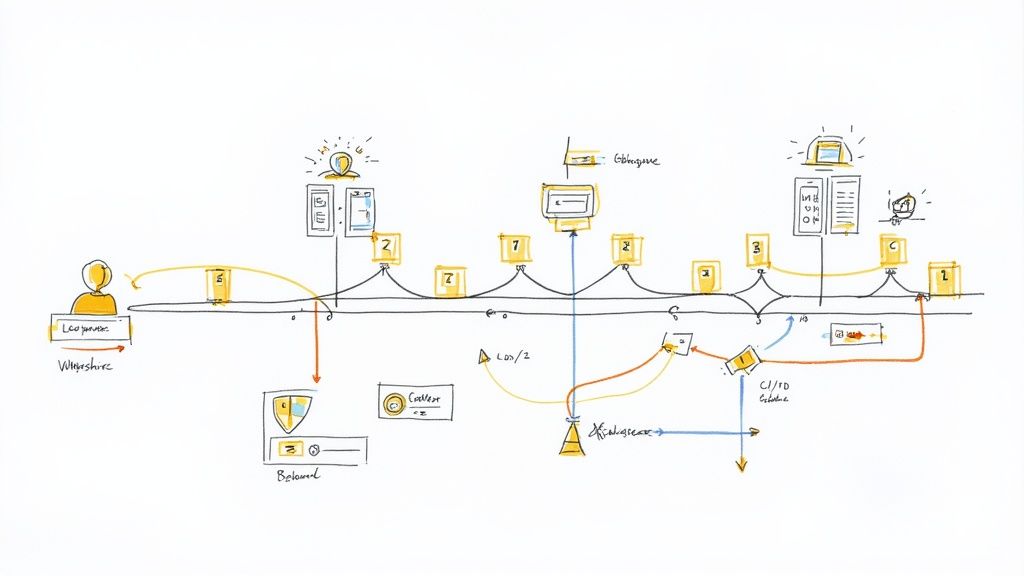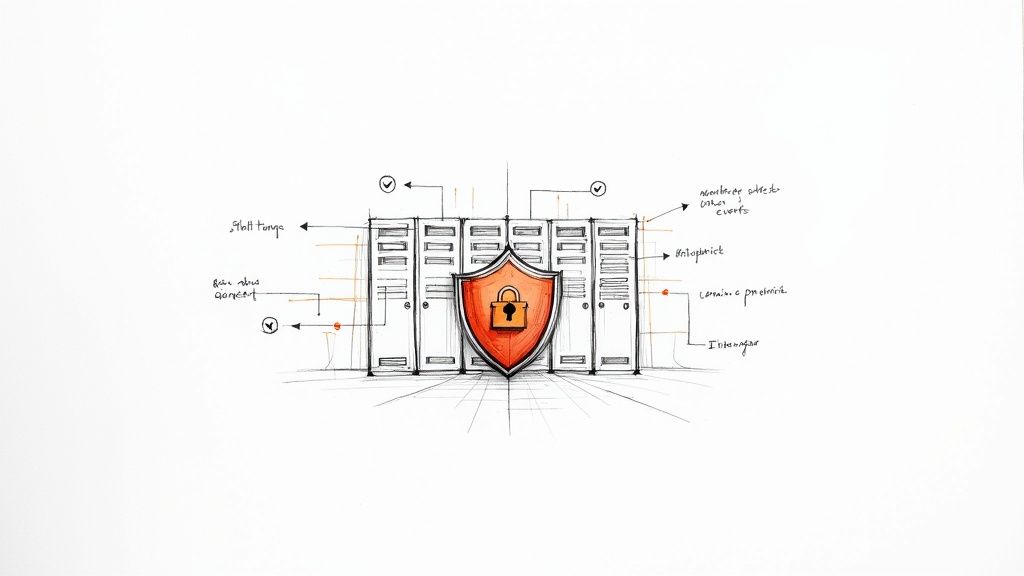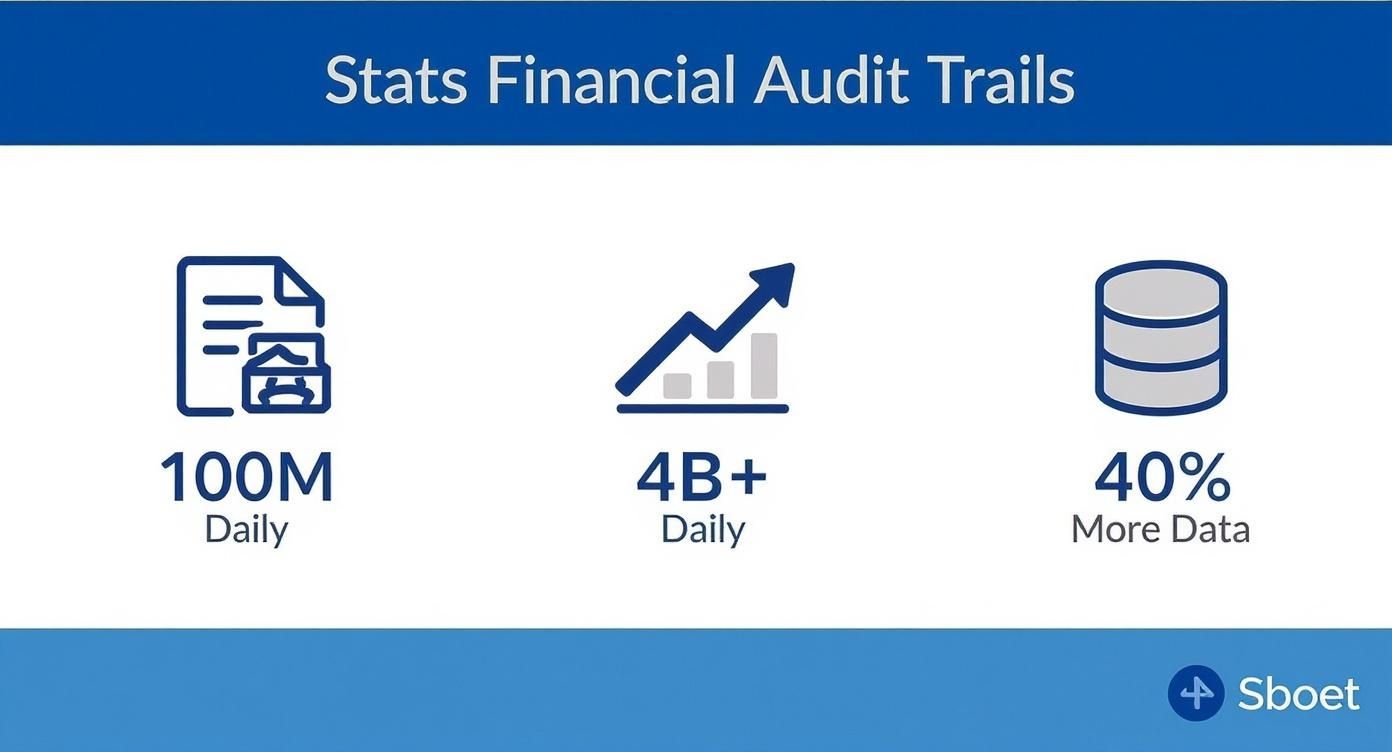What Is an Audit Trail and Why Is It Essential

An audit trail is a chronological, unchangeable record detailing who did what, when, and where within a digital system. Think of it as a digital detective's logbook that captures every significant action, from a file being accessed to a configuration being changed. Its primary purpose is to create a definitive source of truth for accountability and analysis.
What Is an Audit Trail A Digital Detective's Logbook
Imagine trying to solve a puzzle without seeing how the pieces were placed. That’s what troubleshooting or investigating a security breach feels like without a proper audit trail. An audit trail provides that crucial step-by-step history, making it possible to reconstruct events with certainty. It’s not just a simple log of activities; it's a structured, secure record designed for scrutiny.
This record is fundamental for anyone responsible for system integrity, including developers, security analysts, and compliance officers. Instead of asking "what happened?", teams can consult the audit trail to find concrete answers.

Core Components of a Trustworthy Logbook
To be effective, an audit trail must capture specific details that together create a complete picture of an event. A vague entry like "user logged in" is pretty much useless. A useful trail provides granular context.
The real power of an audit trail isn't just in what it records, but in its immutability. A record that can be altered is not a record—it's just a note.
A comprehensive audit trail needs to capture the essential "who, what, when, and where" for every event. These data points are the building blocks of a reliable record-keeping system.
Key Components of a Comprehensive Audit Trail
This table breaks down the essential information every effective audit trail must capture to provide a complete picture of system activity.
| Component | What It Records | Why It's Critical |
|---|---|---|
| Who | The specific user account, API key, or system process that initiated the action. | Establishes clear accountability by linking every action to a unique identity. No more guessing games. |
| What | A clear description of the event, like 'file_deleted,' 'permission_changed,' or 'data_exported.' | Provides immediate context, letting you know exactly what happened without having to piece together cryptic log messages. |
| When | An accurate, synchronized timestamp detailing the exact date and time. | Creates a precise timeline, which is absolutely essential for reconstructing the sequence of events during an investigation. |
| Where | The origin of the action, such as an IP address, workstation, or application module. | Helps pinpoint the source of an activity, which is crucial for identifying unauthorized access or system vulnerabilities. |
By capturing these details, an audit trail moves beyond a simple log file to become a powerful tool for forensics and operational insight.
This detailed, sequential record forms the bedrock for accountability. It enables organizations to confidently investigate security incidents, troubleshoot complex operational issues, and, most importantly, prove compliance during an audit. Without this digital detective's logbook, tracing problems back to their source becomes a nearly impossible task.
Why Audit Trails Are Your Business's Silent Guardian
Think of an audit trail as a silent guardian, one that's always watching over your business. It's not just about logging events; it's about creating an objective, unchangeable story that protects you from both internal mistakes and external threats.
This chronological history is the bedrock for three pillars of any healthy organization: operational integrity, security forensics, and regulatory compliance. Each one leans heavily on the clear-cut narrative that only a good audit trail can provide.
When something inevitably breaks—a system crashes, a service goes down—the first priority is getting back online. Fast. An audit trail gives your team the step-by-step playback needed to troubleshoot effectively. It lets them trace the chain of events that led to the failure, pinpointing the exact change or action that broke things. This is how you slash downtime and make sure the same problem doesn't happen again.

Enabling Security Forensics
If you ever face a security breach, your audit trail instantly becomes the most critical tool for your incident response team. It's the digital equivalent of a crime scene investigation, allowing analysts to meticulously reconstruct an attacker's every move.
By digging into the trail, your security folks can answer the most pressing questions:
- How did the breach occur? The logs will point straight to the initial unauthorized access.
- What was compromised? The trail shows exactly which files were touched, changed, or stolen.
- When did it happen? Timestamps create a precise timeline of the entire incident from start to finish.
This kind of forensic data is absolutely essential for understanding the full scope of an attack, patching vulnerabilities, and hardening your defenses. A solid audit trail is a non-negotiable part of any serious enterprise software security strategy.
Simplifying Regulatory Compliance
For any business operating in regulated spaces like finance, healthcare, or government, audit trails aren't just a good idea—they're the law.
Standards like GDPR, HIPAA, and ISO 27001 all demand that organizations keep detailed records of who is accessing and changing sensitive data.
An audit trail is your proof of diligence. When regulators ask for evidence of your security controls, a comprehensive audit log provides a direct and verifiable answer, demonstrating that you are actively monitoring and protecting critical information.
These logs are your concrete evidence that your company is following the rules. During an official audit, investigators will pour over these trails to verify your controls are in place and actually working. A spotty or non-existent audit trail can lead to crippling fines, lost certifications, and a serious blow to your reputation.
Ultimately, this silent guardian does more than just watch. It delivers the accountability and visibility you need to keep systems stable, respond to threats, and operate with confidence. It turns abstract policies into concrete, reviewable actions.
Of course, the concept of an audit trail is one thing. Seeing it in action is where you really grasp its power. These digital breadcrumbs aren't just some abstract technical checkbox; they're the bedrock of transparency, security, and accountability for countless industries.
Let's look at how these chronological logs work in two incredibly high-stakes environments: finance and healthcare. The core idea is the same, but the applications are specific, and getting them right is non-negotiable.
Upholding Integrity in Financial Markets
In the world of finance, every single transaction has to be recorded with surgical precision. Audit trails are what make this possible, tracking every stock trade, fund transfer, and balance adjustment. This isn't just good practice—it's the law.
Financial institutions operate under a microscope. In the United States, for example, the Securities and Exchange Commission (SEC) demands that broker-dealers keep a complete, time-stamped record of every securities transaction. It's a massive job. The National Securities Clearing Corporation (NSCC) processed an average of 100 million transactions per day as of 2023.
These audit trails must be stored for at least six years, and dropping the ball can lead to penalties up to $5 million per violation. The New York Stock Exchange (NYSE), which sees over 4 billion shares traded daily, depends on these logs to reconstruct events when a dispute or investigation comes up. To see how this plays out in practice, it's worth exploring modern bank audit strategies.
An audit trail in finance is the ultimate truth-teller. It ensures that every dollar and every share is accounted for, leaving no room for ambiguity or fraud in a system built on trust.
This obsessive level of detail is exactly what props up market stability and keeps investors confident. It's a perfect example of how audit trails are so much more than just logs—they're essential infrastructure.
Protecting Sensitive Patient Data in Healthcare
Now let's switch gears to healthcare. Here, the focus of an audit trail shifts from financial assets to something far more personal: your health data. Protecting this information is a top priority, and regulations like the Health Insurance Portability and Accountability Act (HIPAA) in the U.S. enforce strict controls over who can access electronic health records (EHR).
An audit trail is the main tool for making sure those rules are followed. It meticulously records every single interaction with a patient's file:
- Who accessed the record? The log shows the exact user, whether it’s a doctor, nurse, or billing administrator.
- What did they do? The trail documents if they just viewed the file, made an edit, or downloaded information.
- When did it happen? A precise timestamp is attached to every single action.
This granular visibility is critical. If a patient’s data is ever accessed improperly, the audit trail provides the hard evidence needed to investigate the breach and hold the right people accountable. This turns raw log data into a powerful form of software observability, giving organizations a clear window into how their most sensitive information is being handled.
Navigating Security and Compliance Mandates
For a lot of organizations, it's not a question of if they should have audit trails, but how they can make sure those trails meet tough legal and security rules. Regulatory compliance is often the main reason, turning these detailed logs from a good technical habit into something the business absolutely cannot do without. They become the official proof that you've done your due diligence when the auditors show up.
Think of an audit trail as the official story that proves you’re following data protection laws. Without it, showing you've handled sensitive information responsibly is a nearly impossible task. This detailed, time-stamped evidence is what builds trust in a highly regulated world.
This infographic gives you a sense of the sheer volume of data that a modern audit trail needs to keep up with.

As you can see, these systems are processing a massive amount of transactions and data every single day, which underscores just how vital they are for keeping things transparent at scale.
The High Stakes of Non-Compliance
Let's be blunt: failing to keep proper logs can have serious consequences. Major data protection standards around the world don't just suggest having audit trails—they require them.
Regulations like the European Union’s General Data Protection Regulation (GDPR) and the U.S. Health Insurance Portability and Accountability Act (HIPAA) treat audit trails as a core part of compliance. GDPR fines can skyrocket to €20 million or 4% of your global annual revenue, whichever is higher. Likewise, HIPAA demands meticulous tracking of who accesses electronic health records, which is why 78% of U.S. healthcare organizations had automated audit trail systems in place as of 2023.
An audit trail isn't just a log file; it's your company's official testimony in the court of regulatory review. It provides the hard evidence needed to prove that your security policies aren't just words on a page but are actively enforced every minute of every day.
This kind of scrutiny makes having solid, dependable logging a critical part of managing risk.
Meeting Global Security Standards
It’s not just governments, either. International information security standards also lean heavily on audit trails. These frameworks offer a roadmap for building and maintaining a secure environment for your operations.
Here are a few key standards where audit trails are essential:
- ISO 27001: This is the global gold standard for information security. It explicitly requires organizations to create and keep audit logs. If you can't, you risk losing your certification—a huge problem for any business that deals with sensitive client data.
- SOC 2: Built for service providers, SOC 2 reports look at how well a company controls things like security, availability, and confidentiality. For the auditors verifying these controls, audit trails are one of the first places they look for evidence.
For any business looking to check its digital defenses, a good cyber security audit checklist is a great place to start to make sure nothing is missed. At the end of the day, a detailed audit trail is the tangible proof that your organization is living up to its security and compliance promises, protecting both itself and its customers.
Enhancing CI/CD Workflows with Better Audit Trails
In the fast-paced world of software development, the CI/CD pipeline is the engine that keeps innovation moving. For a long time, the logs from this engine were pretty simple: a build either passed or it failed. That binary view just doesn't cut it anymore. Today’s development teams need to ship code faster and more reliably, which demands a much deeper look into every single stage of the process.
This is where a detailed audit trail stops being a nice-to-have and becomes a genuine strategic asset. It cracks open the CI/CD "black box," turning it into a transparent, fully analyzable system. Instead of just knowing a build failed, your team can see precisely why it failed, when the trouble started, and which specific change broke the build.
This is a fundamental shift from just reacting to logs to proactively analyzing the entire workflow. A granular audit trail captures every action—every code commit, every test run, every deployment attempt—and transforms it into structured, actionable data.

From Raw Logs to Root Cause Analysis
Imagine a build that used to take five minutes now grinds along for fifteen. Without a detailed audit trail, your developers are left guessing. They might waste hours sifting through mountains of raw, unstructured logs, hoping to find a clue. It’s slow, frustrating, and a massive drain on productivity.
A proper audit trail for your CI/CD workflow gives you the context needed to solve these problems in minutes, not hours. It answers the critical questions that simple logs just can't:
- Performance Bottlenecks: Is one specific testing stage slowing everything down? The trail can pinpoint the exact job causing the delay.
- Flaky Tests: Are intermittent test failures constantly disrupting builds? An audit history can reveal patterns and help you isolate those unreliable tests for good.
- Infrastructure Issues: Did a deployment fail because of a wonky environment? The logs can clearly distinguish between a code error and a platform problem.
A great CI/CD audit trail doesn't just tell you that something broke; it gives you a detailed blueprint of the failure. This lets engineering teams spend less time debugging and more time building features that matter.
This level of detail is essential for keeping up momentum and ensuring software quality. It also strengthens accountability by clearly linking every change and its outcome to a specific commit and author—a core principle of strong CI/CD security best practices.
Accelerating Development Cycles
At the end of the day, the goal of any CI/CD pipeline is to get high-quality software to users quickly and safely. An effective audit trail directly supports this mission by creating a tight, immediate feedback loop for developers. When a build breaks, they get instant, context-rich information that helps them fix the issue and get back to coding.
This accelerated problem-solving creates a powerful ripple effect across the whole engineering organization. It cuts down on developer frustration, stops the same issues from popping up again and again, and builds confidence in the entire deployment process. By treating the audit trail as a first-class citizen, teams can turn a stream of operational data into a powerful tool for continuous improvement and faster delivery.
Here's the rewritten section, crafted to sound like an experienced human expert:
Turning Raw Data into Actionable CI/CD Insights
Collecting raw data from an audit trail is one thing. But the real magic happens when you turn that mountain of information into something your engineering team can actually use to make better decisions. Let’s be honest, without the right tools, audit logs are just noise—a chaotic stream of events that are nearly impossible to make sense of.
This is where specialized analytics platforms come in. Think of them as a translator. They take the raw, jumbled data from your CI/CD audit trail and present it through clean dashboards and visuals. This is what shifts a team from a reactive "what just broke?" panic to a proactive mindset focused on constant improvement.
Instead of a developer having to manually dig through endless log files just to figure out a slowdown, they can glance at a performance trend graph. Suddenly, the frustrating questions that eat up development time have clear, visual answers.
Answering the Questions That Really Matter to Developers
A well-designed analytics dashboard cuts through the clutter to answer the questions your engineering team is already asking. It transforms abstract data points into a clear picture of what’s happening on the ground.
Here’s how it helps:
- "Why did my build suddenly slow down?" A dashboard can instantly show you build times over the last week or month, pinpointing the exact day things went south. This makes it simple to connect a performance dip to a specific code change or infrastructure update.
- "Which change introduced this bug?" By linking every single deployment to a specific set of code commits, the system makes it trivial to trace a new bug straight back to its source. No more guesswork.
- "Is this a flaky test or a real problem?" Analytics can track the success rate of individual tests over time. This helps you tell the difference between a test that’s consistently failing (a real bug) and one that’s just unreliable, saving developers from chasing ghosts.
By presenting audit trail data visually, you empower everyone on the team to become a detective. They no longer need to be a logging expert to diagnose a problem; the insights are surfaced for them.
This approach transforms the answer to "what is an audit trail" from a simple data log into a powerful strategic asset. It gives developers the context they need to fix issues faster, optimize their pipelines, and ultimately, ship higher-quality code with a whole lot more confidence and less frustration.
A Few Lingering Questions
As you start to think about putting audit trails to work, a couple of questions usually pop up. Getting these details straight is the difference between simply knowing what an audit trail is and knowing how to manage one effectively. Let's clear up a few final points.
What’s the Difference Between an Audit Trail and a Log File?
This is a classic. While they're related, audit trails and log files are definitely not the same thing.
A log file is just a running record of system events. Developers use them all the time for debugging or just to see what the system is doing. An audit trail, on the other hand, is a very specific type of log built for security and accountability. It’s all about answering "who did what, when, and from where?" for critical actions.
The real kicker? Audit trails are designed to be tamper-evident.
How Long Should We Keep Audit Trails?
There's no single answer here—it really depends on your industry and any legal hoops you have to jump through.
For instance, financial regulations might demand you keep records for six years or more. Healthcare rules like HIPAA also mandate a six-year retention period. A good rule of thumb for security standards like ISO 27001 is to hang on to them for at least three years.
The best approach is to figure out which compliance frameworks apply to your organization and align your retention policy with their specific requirements.
A well-designed audit trail has strong protections to prevent unauthorized changes, such as write-once storage and cryptographic hashing to verify data integrity. Its immutability is what makes it a reliable source of truth during an investigation.
Ready to turn your CI/CD logs from raw data into something you can actually use? Mergify's CI Insights gives your team the observability needed to diagnose failures faster, optimize performance, and ship code with confidence. See how it works at https://mergify.com.





